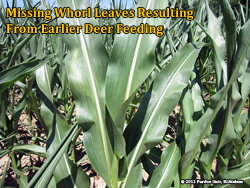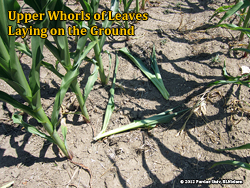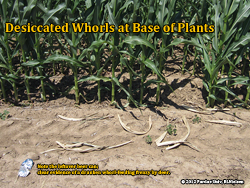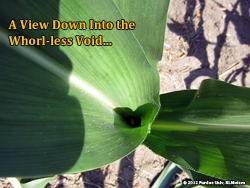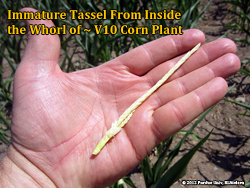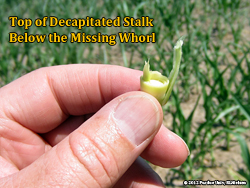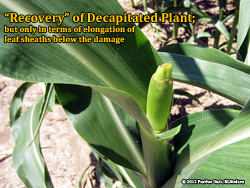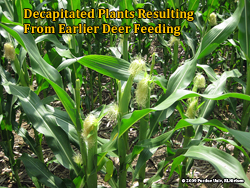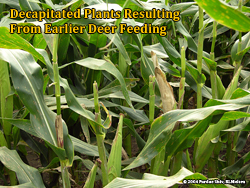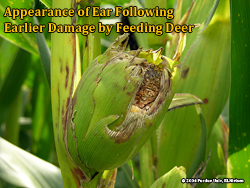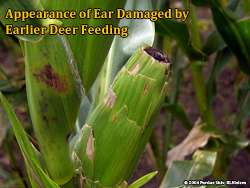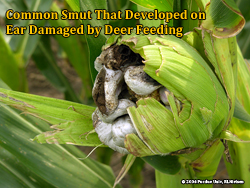July 2020
URL: http://www.kingcorn.org/news/timeless/DeerDamage.html
Decapitation of Corn Plants by Deer
R.L. (Bob) Nielsen
Agronomy Dept., Purdue Univ.
West Lafayette, IN 47907-2054
Email address: rnielsen at purdue.edu
Twitter: @PurdueCornGuy
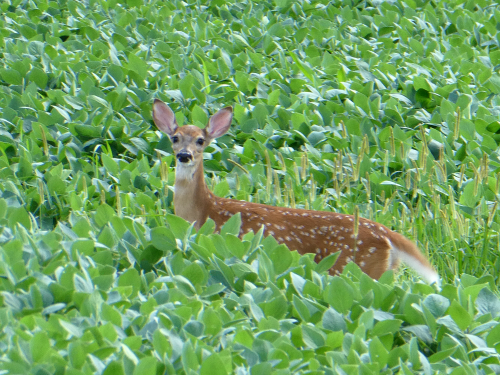
Early in the growing season, deer will sometimes feed on the whorls or tops of young plants from about growth stage V10 (ten leaves with visible leaf collars) to about V16 when the immature tassel, still inside the whorl, is 4 to 6 inches long. Rather than actually eat the whorl leaves, the deer are apparently attracted to the succulent immature tassel. The results are decapitated plants whose young whorl leaves have simply been pulled out and (I can only imagine) the tassel somehow teased out and eaten. The mostly intact, though no longer attached, whorl leaves are left behind on the ground along with the tell-tale evidence of hoof prints and deer scat. The decapitated plants usually survive and ear development will continue through pollination and on to maturity, though the ears are usually less than full size owing to the fact that most of the photosynthetic leaf area above the ears is missing.
These animals are also attracted to corn fields at about the time kernels reach milk stage of development (R3), often referred to as the "roasting ear" stage, in early to mid-August. The common symptoms resulting from deer feeding on corn at this stage of development are decapitated ears. The ear symptoms are sometimes mistaken for bird damage, but differ because of the distinct appearance of "cut" husks and missing ends of cobs resulting from the deer "chomping" off the ends of the ears. Bird damage (crows, blackbirds, etc) more typically results in shredded ends of husks and barren cob tips.
Fortunately, deer damage to corn is often limited to the outer rows around the field edges. However, small fields of corn completely surrounded by woodlots or forest areas can sustain significant damage throughout the entire field by deer grazing in mid-August. Deer damage to plants or ears of corn during the grain filling period often results in disease infection of the damaged plant tissue by common smut (Ustilago maydis) spores. This disease eventually develops into the ugly or beautiful (eyes of the beholder) mass of fungal tissue on damaged plant parts.
Related reading
Anderson, Eric and James DeDecker. 2019. How to keep your crop field from becoming a wildlife food plot. Michigan State Univ. Extension. https://www.canr.msu.edu/news/how-to-keep-your-crop-field-from-becoming-a-wildlife-food-plot [URL accessed July 2020]
MacGowan, Brian, Lee Humberg, James Beasley, Travis DeVault, Monica Retamosa and Olin Rhodes, Jr. 2006. Corn and Soybean Crop Depradation by Wildlife. Purdue Univ, http://www.extension.purdue.edu/extmedia/FNR/FNR-265-W.pdf [URL accessed July 2020].
Pierce, Robert. 2019. Controlling Deer Damage in Missouri. Univ. of Missouri Extension. https://extension2.missouri.edu/mp685 [URL accessed July 2020]
White-tailed Deer (Odocoileus virginianus). 2012. Purdue University Wildlife Crop Damage Site. http://www.agriculture.purdue.edu/fnr/cropdamage/wildlife/deer.htm [URL accessed July 2020].
Click image to view larger version in a popup window. Left or right arrow on your keypad will cycle through the popup images.
